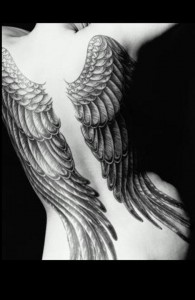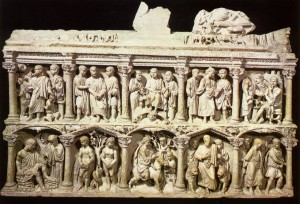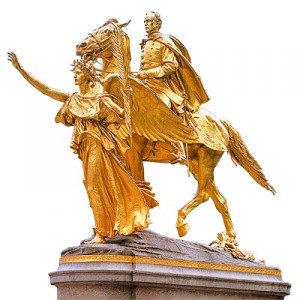
An angel is loosely defined as a winged human figure. We find angel-shaped beings in ancient Mesopotamian art. The dancing goddess was a common representation in the pagan culture. The Greeks had their classical Nike goddess figure and the Romans simply adapted her likeness in their art. These images were probably the inspiration for the Christian image of angels as artists adapted the Greco-Roman goddess into a spiritual being associated with the concept of light and dark as portrayal of Biblical imagery.
The earliest Christian angelic image can be found on the Cubicolo dell’Annunziazione, located in the Catacomb of Priscilla outside Rome, and dating from mid-third century. The angel has no wings. Other contemporary representations on sarcophagi and reliquaries show non-winged angels. St. John Chrysostom wrote that “they manifest their nature’s sublimity. Not that angels have wings, but that you may know that they leave the heights and the most elevated dwelling to approach human nature.”

Little changed in this Hellenistic concept of angels as art moved from the early Christian era into the Middle Ages. Given the rather superstitious and otherworldly approach to medieval religion, a vast quantity of angel lore grew up around the Biblical stories, lives of the saints, and the subsequent depiction in art. Angels of The Light and angels of The Dark existed side by side in a glorious panorama of legend. Within the medieval period we first encounter multi-winged angels. Derived from ancient Persian art, the multi-winged creatures, usually the upper-echelon cherubim and seraphim and often showing only face and wings, stay within a heavenly context as opposed to performing tasks on earth. These angels like to perch in the pendentives of church domes.
With the coming of the Renaissance the depiction of angels returned to a more classical approach. We see angels not only present in artistic renderings of Scripture, but in that Hellenistic tradition of angels as muses of the arts. Of all the beautiful renaissance angels, my favorites are those of Fra Angelico. The early renaissance painter’s angels have multi-colored wings! Colors range from muted earth tones to the bright primary tones of the rainbow. Angelico’s angels are usually portrayed interacting with people, the Annunciation for example, but their colored wings exemplify light: the light of heaven; the light of Christ, as they bring messages and help humanity to carry out the tasks of daily living.
Raphael is perhaps the best-known painter of angels. He had a fondness for putti. A putto, in English we call him a cherub, is a naked boy with wings, usually playful and often unruly. Those poor two putti that lean over the bottom of The Sistine Madonna, have been subjected to a “cigarette and beer” version as well as “dogs with wings.” Baroque and Rococo angels depict a heaven on earth theme, embarking on new levels of richness and complexity. This trend ended abruptly with the French Revolution and the secularization of Europe. But not for long.

So, what do angels represent in our modern society? We still have the artists who depict angels in their various tasks from guardians to worldly gatekeepers. But most angels in our day have been relegated to pop culture and a New Age expression of “good,” whatever that means in a 21st-century context. The Victoria’s Secret angels tell us that “good angels go to heaven. Victoria’s Secret angels go everywhere.” And I suppose you can become sort some of angel by tattooing wings on your back. Maybe Raphael’s poor putti didn’t have it so bad after all.









